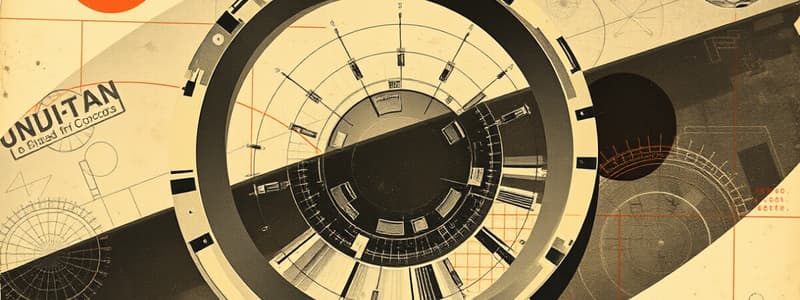Podcast
Questions and Answers
What does 'uniform' mean?
What does 'uniform' mean?
constant
What is uniform in uniform circular motion?
What is uniform in uniform circular motion?
speed and radius are constant
What are the three units for this lesson?
What are the three units for this lesson?
kg, m, s
What is uniform circular motion?
What is uniform circular motion?
Are velocity and acceleration constant?
Are velocity and acceleration constant?
What is the relationship between acceleration and velocity? Are they parallel or perpendicular?
What is the relationship between acceleration and velocity? Are they parallel or perpendicular?
Centripetal acceleration does not change speed, it causes a change in ______________.
Centripetal acceleration does not change speed, it causes a change in ______________.
What is centripetal force?
What is centripetal force?
What are three types of centripetal force?
What are three types of centripetal force?
What is centripetal force: tension?
What is centripetal force: tension?
Are force and acceleration in the same direction?
Are force and acceleration in the same direction?
What is centripetal force: friction?
What is centripetal force: friction?
What is centripetal force: normal force?
What is centripetal force: normal force?
What is directed toward the center?
What is directed toward the center?
As velocity of an object moving through a curve or circular path increases, the force needed to keep it in the circle _________.
As velocity of an object moving through a curve or circular path increases, the force needed to keep it in the circle _________.
As the radius of an object moving in a curve or circle increases, the force needed to keep it in the circle also ________.
As the radius of an object moving in a curve or circle increases, the force needed to keep it in the circle also ________.
When you increase the radius, are you moving at a faster or slower speed compared to the smaller radius?
When you increase the radius, are you moving at a faster or slower speed compared to the smaller radius?
Why do banked tracks help cars make it through a curve?
Why do banked tracks help cars make it through a curve?
What is a period?
What is a period?
What is frequency?
What is frequency?
How are periods and frequency related?
How are periods and frequency related?
What kind of friction holds cars in turns?
What kind of friction holds cars in turns?
What can cause you to crash for turning too violently?
What can cause you to crash for turning too violently?
The normal force felt by someone at the top of an object moving in a vertical circle is ______ than the normal force felt by someone moving at the bottom of the circle.
The normal force felt by someone at the top of an object moving in a vertical circle is ______ than the normal force felt by someone moving at the bottom of the circle.
What is required to move an object along a circular path?
What is required to move an object along a circular path?
What is a spring tide?
What is a spring tide?
What is a neap tide?
What is a neap tide?
What is the unit of frequency?
What is the unit of frequency?
What is the unit of period?
What is the unit of period?
To find period when given frequency, use...
To find period when given frequency, use...
Flashcards are hidden until you start studying
Study Notes
Uniform Circular Motion Overview
- "Uniform" refers to constant values.
- In uniform circular motion, both speed and radius of the path remain constant.
- Relevant units include kilograms (kg), meters (m), and seconds (s).
Characteristics of Uniform Circular Motion
- Defined as an object moving in a circular path at a constant speed around a fixed circumference/radius.
- The velocity and acceleration are not constant due to continuous directional changes.
Acceleration and Velocity Relationship
- Velocity and acceleration are always perpendicular to each other.
- Centripetal acceleration maintains constant speed but alters the direction of the object's motion.
Centripetal Force
- Centripetal force keeps an object in circular motion and can be supplied by various forces.
- Types of centripetal force include:
- Tension: Involves swinging an object attached to a string.
- Friction: Static friction enables cars to navigate circular curves.
- Normal force: For example, the force exerted by the track on a roller coaster car.
Dynamics of Motion
- Both force and acceleration are directed towards the center of the circular path.
- Higher speeds require greater centripetal force to maintain curvature in motion.
- Increased radius also requires a proportional increase in the centripetal force necessary.
Banking and Turning Mechanics
- Banked tracks assist vehicles in turning by providing an inward component of normal force.
- Static friction is crucial for cars negotiating turns, while excessive speed or adverse road conditions may lead to crashes.
Period and Frequency
- The period represents the time needed for one complete revolution.
- Frequency counts the number of revolutions per time unit.
- The period and frequency are reciprocals: T = 1/f.
- Units of measurement include rev/s for frequency and s/rev for period.
Tidal Phenomena
- Spring tides arise when the sun aligns with the moon, producing large tides.
- Neap tides occur when the sun and moon form right angles relative to Earth, resulting in smaller tides.
Exam Preparation
- Review diagrams related to forces acting on moving objects in circular motion.
- Understand relationships between speed, radius, and force for successful navigation of curves.
Studying That Suits You
Use AI to generate personalized quizzes and flashcards to suit your learning preferences.




